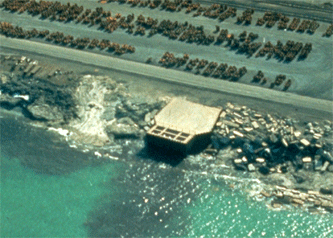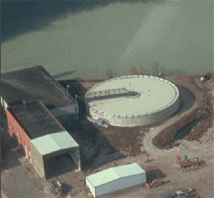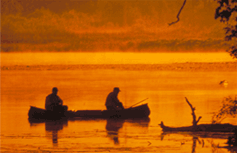Supplemental Module: Listing Impaired Waters and Developing TMDLs
This module covers how States/Tribes identify and prioritize impaired and/or threatened waters for the 303(d) list and develop pollutant loading analyses, commonly known as TMDLs, to help meet the State/Tribe's water quality standards.
-
What is an impaired water?
-
What is the 303(d) list?
-
How do waters get on the 303(d) list?
-
What is a TMDL?
-
How are TMDLs developed?
-
What are TMDL reporting requirements?
At the end of the module is a brief quiz intended to touch on aspects of an impaired waters listing and TMDLs development. These will be further examined in the classroom session of this module.
This module's main pages and brief quiz at the end take about 20 minutes to complete.
303(d) List and TMDLs Development
Under Section 303(d), states and authorized tribes must identify waters for which a water quality standard has not been met, even after required minimum levels of pollution control technology have been adopted. Such waters are considered "water quality-limited" or impaired waters. In addition, EPA guidance provides for listing threatened waters for which readily available data and information show that the water body is currently meeting standards, but that there is a trend toward impairment within the next listing cycle (2 years).
Consistent with the Clean Water Act's (CWA) overall objective to "restore and maintain the chemical, physical and biological integrity of the Nation's waters" (Section 101(a)), states and tribes are required under Section 303(d) to identify, prioritize, and establish TMDLs for such waters — impaired waters. EPA construes this requirement to apply to waters with water quality that is threatened with impairment as well.
Key Point. After a State/Tribe adopts its water quality standards, it should regularly monitor the condition of water bodies within its boundaries. Regular monitoring provides information to help states/tribes identify and prioritize impaired and threatened waters.
For waters identified in their Section 303(d) lists, states and tribes must calculate the maximum amount of a pollutant allowed to enter an impaired water body, known as the loading capacity, so that the water body will meet and continue to meet the State/Tribe's water quality standards for that particular pollutant. These pollutant loadings are calculated in total maximum daily loads (TMDLs), and their development is essential to a State/Tribe's long-term planning for achieving the objectives established by their water quality standards.
303(d) List: Identifying Impaired/Threatened Waters
As a fundamental step for addressing impaired or threatened waters, Section 303(d) and EPA regulations require a State/Tribe to do the following:
- List the impaired/threatened waters within its boundaries that require development of TMDLs. Then for each water body, identify the pollutants causing or expected to cause the impairment, which will be the focus of the TMDLs.
In this first step, as established by the regulation, each State/Tribe must identify "water quality-limited segments still requiring TMDLs within its boundaries" for which (a) technology-based effluent limitations, (b) more stringent effluent limitations, and (c) other pollution-control requirements "are not stringent enough to implement any water quality standards (WQS) applicable to such waters." (40 CFR 130.7)
The assessment of impaired waters has traditionally been a process defined by the State/Tribe, and thus can vary in approach and complexity. Regardless, the process must consider "all existing and readily available water quality-related data and information" (e.g., information included in watershed plans and other types of water quality management plans) (40 CFR 130.7(b)(5)).
303(d) List: Prioritizing Impaired/Threatened Waters
After compiling the list of impaired/threatened water bodies, States/Tribes determine the priority ranking of waters for TMDL development. Under Section 303(d)(1) prioritizing the list must take into account the following for each water body (or segment):
- Severity of the pollution.
- Uses to be made of such waters.
States and tribes may consider other factors such as:
- Risk to human health and aquatic life.
- Degree of public interest and support.
- Recreational, economic, and aesthetic importance.
- Vulnerability or fragility as an aquatic habitat.
- Immediate programmatic needs (e.g., wasteload allocations needed for permits coming up for revision or for new or expanding discharges).
- Court orders and decisions relating to water quality.
- National policies and priorities.
States/Tribes must develop a priority-ranked list of impaired or threatened waters. The regulation recognizes that not all water quality problems can be addressed at once. Nonetheless, the expectation is that over time a State/Tribe will develop and implement TMDLs for all impaired/threatened waters identified within its boundaries. Thus, each State/Tribe must establish multi-year schedules that address near-term development of TMDLs for high-priority waters as well as eventual TMDL development for other waters on the list.
Water Quality Reporting Requirements under CWA
States/Tribes must submit the 303(d) list of impaired/threatened water bodies to EPA by April 1 of all even-numbered years. With each biennial submission, the State/Tribe should indicate which water bodies have been added or removed and which water bodies were assessed since the last submission.
In addition, Section 305(b) requires that every 2 years States/Tribes provide EPA with a description of the water quality of all waters within the State/Tribe's boundaries, including rivers/streams, lakes, estuaries/oceans, and wetlands. The submission must be made by April 1 of all even-numbered years, and EPA must transmit the reports — together with an analysis thereof — to Congress.
Further, Section 314 requires States/Tribes as part of their 305(b) report to submit information to EPA on the water quality status of all publicly owned lakes, including extent of point source and nonpoint source impacts due to toxics, conventional pollutants, and acidification.
The State/Tribe may also include a description of the nature and extent of ground-water pollution and recommendations of State/Tribal plans or programs needed to maintain or improve ground-water quality.
303(d) Submissions: Integrated Report Format
EPA recommends that States/Tribes submit their list of impaired or threatened water bodies in an "integrated report" that also includes their required submissions under Section 305(b) and Section 314. Using the Integrated Report format to submit this information every 2 years satisfies the requirements under all three sections of the Clean Water Act. The submission must be made by April 1 of all even-numbered years.
Resource. For more on the Integrated Report format, refer to EPA's Guidance for 2006 Assessment, Listing, and Reporting Requirements Pursuant to Sections 303(d), 305(b), and 314 of the Clean Water Act.
303(d) Submissions: Integrated Reporting Categories
With the Integrated Report option, EPA encourages States/Tribes to use a five-category system for classifying all water bodies (or segments) within its boundaries regarding the waters' status in meeting the State's/Tribe's water quality standards. The categories are listed. The classification system uses designated uses as the basis for reporting on water quality.
| Category/Subcategory | Description |
|---|---|
| Category 1 | All designated uses are supported, no use is threatened. |
| Category 2 | Available data and/or information indicate that some, but not all, designated uses are supported. |
| Category 3 | There is insufficient available data and/or information to make a use support determination. |
| Category 4 | Available data and/or information indicate that at least one designated use is not being supported or is threatened, but a TMDL is not needed. |
|
A State developed TMDL has been approved by EPA or a TMDL has been established by EPA for any segment-pollutant combination. |
|
Other required control measures are expected to result in the attainment of an applicable water quality standard in a reasonable period of time. |
|
The non-attainment of any applicable water quality standard for the segment is the result of pollution and is not caused by a pollutant. |
| Category 5 | Available data and/or information indicate that at least one designated use is not being supported or is threatened, and a TMDL is needed. |
The waters from Category 5 constitute the Section 303(d) list of impaired or threatened waters within the State/Tribe's boundaries.
TMDL Development: Introduction

A TMDL is a calculation of the maximum amount of a pollutant that a water body (or segment) can receive and still meet the state/tribe’s water quality standards—and an allocation of that amount to the pollutant’s sources. In this way, the TMDL provides the basis for establishing water quality-based controls that should provide the pollution reduction necessary for a water body to meet the standards.
A TMDL is the sum of the allocations to sources that cause or threaten a water body with impairment, and includes a margin of safety to account for uncertainty in the response of the water body to loading reductions. Pollutant sources include both:
-
Point source (PS). Pollutant loads discharged at a specific location from pipes, outfalls, and conveyance channels from either municipal wastewater treatment plants or industrial waste treatment facilities. Point sources can also include pollutant loads contributed by tributaries to the main receiving water stream or river.
- Nonpoint source (NPS). Pollution that is not released through pipes but rather originates from multiple sources over a relatively large area. Nonpoint sources can be divided into source activities related either to land or water use, including failing septic tanks, improper animal-keeping practices, forestry practices, and urban and rural runoff.
TMDL Development: The Basic Calculation
A TMDL is a calculation defined by this basic formula:
TMDL = ΣWLA i + ΣLAi + MOS
That is, a TMDL is the sum of the following.
- Waste load allocation (WLA). Total amount of pollutant from existing point sources (e.g., sewage treatment plant, industrial facility, stormwater).
- Load allocation (LA). Total amount of pollutant from existing nonpoint sources and natural background (e.g., farm runoff, atmospheric mercury).
- Margin of safety (MOS). This is used to take into account lack of knowledge concerning the relationship between effluent limitations and water quality. It can be expressed as an explicit factor (e.g., percent of total, such as 10%) or an implicit factor (e.g., conservative assumption in modeling).
Summary of TMDL Development Activities
- Selection of the pollutant to consider.
- Estimation of the water body's assimilative capacity (i.e., loading capacity).
- Estimation of the pollutant loading from all sources to the water body.
- Analysis of current pollutant load and determination of needed reductions to meet assimilative capacity.
- Allocation (with a margin of safety) of the allowable pollutant load among the different pollutant sources in a manner that water quality standards are achieved.
TMDL Development: Documentation and Review
The TMDL document must include components required by statute or regulation. EPA guidance recommends additional components.
|
Elements of a Typical TMDL Document |
Regulations |
EPA |
|---|---|---|
| Identification of water body, pollutant of concern, pollutant sources, and priority ranking. |
√
|
|
| Applicable water quality standards. |
√
|
|
| Loading capacity. |
√
|
|
| Load allocations and waste load allocations. |
√
|
|
| Margin of safety. |
√
|
|
| Consideration of seasonal variation. |
√
|
|
| Reasonable assurance for point source/nonpoint sources. |
√
|
|
| Monitoring plan to track TMDL effectiveness. |
√
|
|
| Implementation plan. |
√
|
|
| Public participation. |
√
|
TMDL Implementation: Pollutant Source Control Mechanisms

TMDLs are not self-implementing under Section 303(d); however, existing implementation mechanisms vary depending on the source of the pollutant(s):
- Point sources. Allocations to point sources get implemented through permits that are consistent with the WLA in the TMDL. These permits are enforceable under the Clean Water Act through the National Pollutant Discharge Elimination System (NPDES). Permits are issued by EPA or States/Tribes with delegated authority.
- Nonpoint sources. There is no federal enforcement program for control of nonpoint source pollution. Nonpoint source controls are primarily implemented through State/Tribal and local nonpoint source management programs. Some of these State/Tribal or local programs have regulatory enforcement authority.
303(d) List and TMDLs: Public Participation
Public participation is required as part of the development of 303(d) lists and TMDLs. For instance, landowners, watershed organizations, government agencies, and other stakeholders often assist with the process.
Participation may include the following:
- The public has the opportunity to provide data and information that the state/tribe may use—based on reasonable standards of quality—to make listing determinations.
- The public can review and comment on draft impaired waters lists.
- Once the draft TMDL is completed for a listed water, the public may review and comment on the proposed TMDL.
- The public can also work with the state/tribe to develop a third-party TMDL.
More generally, the public is encouraged to become involved in the TMDL process by joining (or starting) a watershed, lake, or river association. Such groups can provide opportunities to monitor water quality, identify pollution sources, and identify possible control actions.
Summary
-
States and Tribes are required under CWA Section 303(d) to identify, prioritize, and establish TMDLs for impaired waters as well as those with water quality that is threatened with impairment. States/Tribes must submit the 303(d) list of impaired/threatened water bodies to EPA every 2 years.
-
In addition, Section 305(b) requires that States/Tribes submit a description of the water quality of all waters in the State/Tribe's boundaries. Further, Section 314 requires States/Tribes as part of their 305(b) report to submit information to EPA on the water quality status of all publicly owned lakes.
-
EPA encourages States/Tribes to submit their list of impaired or threatened water bodies in an "integrated report" that also includes their required submissions under Section 305(b) and Section 314. Using the Integrated Report option to submit this information satisfies the requirements under all three sections of the CWA.
-
States and Tribes must develop TMDLs for each water body/pollutant combination identified on the 303(d) list. The allocations to point and nonpoint sources in the TMDL provide the basis for establishing water quality-based controls that—when implemented — should result in attainment of standards.
-
The TMDL document must include components required by statute or regulation. EPA guidance recommends additional components.
- TMDLs are not self-implementing. Rather, existing implementation mechanisms vary depending on the source: Point source controls are enforceable under the NPDES permit program. Nonpoint source controls are primarily implemented through State/Tribal and local nonpoint source management programs.
Quiz
To complete your review of the topic in this module, please take the following brief quiz.
A note about the quiz: Your answers will NOT be scored or recorded. However, selecting the Submit button for each question will provide you with the correct answers on screen.
Answer each of the questions
Disclaimer: This online course presentation and any associated links have been prepared by EPA staff for informational purposes only. Their sole purpose is to make available training online from recent Water Quality Standards Academy classroom courses. As such, this online course and any associated links are not binding on EPA or the public and have no legal effect. They do not constitute an EPA statute, regulation or other requirement and do not substitute for such authorities. In addition, the course and any associated links have not been reviewed or endorsed by EPA management. Thus, they are not intended or written as official statements of EPA's scientific views, policies, guidance, or requirements and cannot be used or cited as evidence of EPA's position on any matter.

